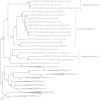Casposons: a new superfamily of self-synthesizing DNA transposons at the origin of prokaryotic CRISPR-Cas immunity
- PMID: 24884953
- PMCID: PMC4046053
- DOI: 10.1186/1741-7007-12-36
Casposons: a new superfamily of self-synthesizing DNA transposons at the origin of prokaryotic CRISPR-Cas immunity
Abstract
Background: Diverse transposable elements are abundant in genomes of cellular organisms from all three domains of life. Although transposons are often regarded as junk DNA, a growing body of evidence indicates that they are behind some of the major evolutionary innovations. With the growth in the number and diversity of sequenced genomes, previously unnoticed mobile elements continue to be discovered.
Results: We describe a new superfamily of archaeal and bacterial mobile elements which we denote casposons because they encode Cas1 endonuclease, a key enzyme of the CRISPR-Cas adaptive immunity systems of archaea and bacteria. The casposons share several features with self-synthesizing eukaryotic DNA transposons of the Polinton/Maverick class, including terminal inverted repeats and genes for B family DNA polymerases. However, unlike any other known mobile elements, the casposons are predicted to rely on Cas1 for integration and excision, via a mechanism similar to the integration of new spacers into CRISPR loci. We identify three distinct families of casposons that differ in their gene repertoires and evolutionary provenance of the DNA polymerases. Deep branching of the casposon-encoded endonuclease in the Cas1 phylogeny suggests that casposons played a pivotal role in the emergence of CRISPR-Cas immunity.
Conclusions: The casposons are a novel superfamily of mobile elements, the first family of putative self-synthesizing transposons discovered in prokaryotes. The likely contribution of capsosons to the evolution of CRISPR-Cas parallels the involvement of the RAG1 transposase in vertebrate immunoglobulin gene rearrangement, suggesting that recruitment of endonucleases from mobile elements as ready-made tools for genome manipulation is a general route of evolution of adaptive immunity.
Figures




Similar articles
-
Recent Mobility of Casposons, Self-Synthesizing Transposons at the Origin of the CRISPR-Cas Immunity.Genome Biol Evol. 2016 Jan 13;8(2):375-86. doi: 10.1093/gbe/evw006. Genome Biol Evol. 2016. PMID: 26764427 Free PMC article.
-
Self-synthesizing transposons: unexpected key players in the evolution of viruses and defense systems.Curr Opin Microbiol. 2016 Jun;31:25-33. doi: 10.1016/j.mib.2016.01.006. Epub 2016 Feb 1. Curr Opin Microbiol. 2016. PMID: 26836982 Free PMC article. Review.
-
Casposons - silent heroes of the CRISPR-Cas systems evolutionary history.EXCLI J. 2023 Jan 5;22:70-83. doi: 10.17179/excli2022-5581. eCollection 2023. EXCLI J. 2023. PMID: 36814855 Free PMC article. Review.
-
Mobile Genetic Elements and Evolution of CRISPR-Cas Systems: All the Way There and Back.Genome Biol Evol. 2017 Oct 1;9(10):2812-2825. doi: 10.1093/gbe/evx192. Genome Biol Evol. 2017. PMID: 28985291 Free PMC article. Review.
-
CRISPR-Cas immunity and mobile DNA: a new superfamily of DNA transposons encoding a Cas1 endonuclease.Mob DNA. 2014 Aug 26;5:23. doi: 10.1186/1759-8753-5-23. eCollection 2014. Mob DNA. 2014. PMID: 25180049 Free PMC article.
Cited by
-
Evolutionary Dynamics of Transposable Elements Following a Shared Polyploidization Event in the Tribe Andropogoneae.G3 (Bethesda). 2020 Dec 3;10(12):4387-4398. doi: 10.1534/g3.120.401596. G3 (Bethesda). 2020. PMID: 32988994 Free PMC article.
-
SMART: recent updates, new developments and status in 2020.Nucleic Acids Res. 2021 Jan 8;49(D1):D458-D460. doi: 10.1093/nar/gkaa937. Nucleic Acids Res. 2021. PMID: 33104802 Free PMC article.
-
Evolutionary classification of CRISPR-Cas systems: a burst of class 2 and derived variants.Nat Rev Microbiol. 2020 Feb;18(2):67-83. doi: 10.1038/s41579-019-0299-x. Epub 2019 Dec 19. Nat Rev Microbiol. 2020. PMID: 31857715 Free PMC article. Review.
-
Virus-host arms race at the joint origin of multicellularity and programmed cell death.Cell Cycle. 2014;13(19):3083-8. doi: 10.4161/15384101.2014.949496. Cell Cycle. 2014. PMID: 25486567 Free PMC article.
-
The casposon-encoded Cas1 protein from Aciduliprofundum boonei is a DNA integrase that generates target site duplications.Nucleic Acids Res. 2015 Dec 15;43(22):10576-87. doi: 10.1093/nar/gkv1180. Epub 2015 Nov 16. Nucleic Acids Res. 2015. PMID: 26573596 Free PMC article.
References
-
- Lander ES, Linton LM, Birren B, Nusbaum C, Zody MC, Baldwin J, Devon K, Dewar K, Doyle M, FitzHugh W, Funke R, Gage D, Harris K, Heaford A, Howland J, Kann L, Lehoczky J, LeVine R, McEwan P, McKernan K, Meldrim J, Mesirov JP, Miranda C, Morris W, Naylor J, Raymond C, Rosetti M, Santos R, Sheridan A, Sougnez C. et al.Initial sequencing and analysis of the human genome. Nature. 2001;12:860–921. doi: 10.1038/35057062. - DOI - PubMed
-
- Venter JC, Adams MD, Myers EW, Li PW, Mural RJ, Sutton GG, Smith HO, Yandell M, Evans CA, Holt RA, Gocayne JD, Amanatides P, Ballew RM, Huson DH, Wortman JR, Zhang Q, Kodira CD, Zheng XH, Chen L, Skupski M, Subramanian G, Thomas PD, Zhang J, Gabor Miklos GL, Nelson C, Broder S, Clark AG, Nadeau J, McKusick VA, Zinder N. et al.The sequence of the human genome. Science. 2001;12:1304–1351. doi: 10.1126/science.1058040. - DOI - PubMed
-
- López-Flores I, Garrido-Ramos MA. The repetitive DNA content of eukaryotic genomes. Genome Dyn. 2012;12:1–28. - PubMed
Publication types
MeSH terms
Substances
Grants and funding
LinkOut - more resources
Full Text Sources
Other Literature Sources
Molecular Biology Databases

